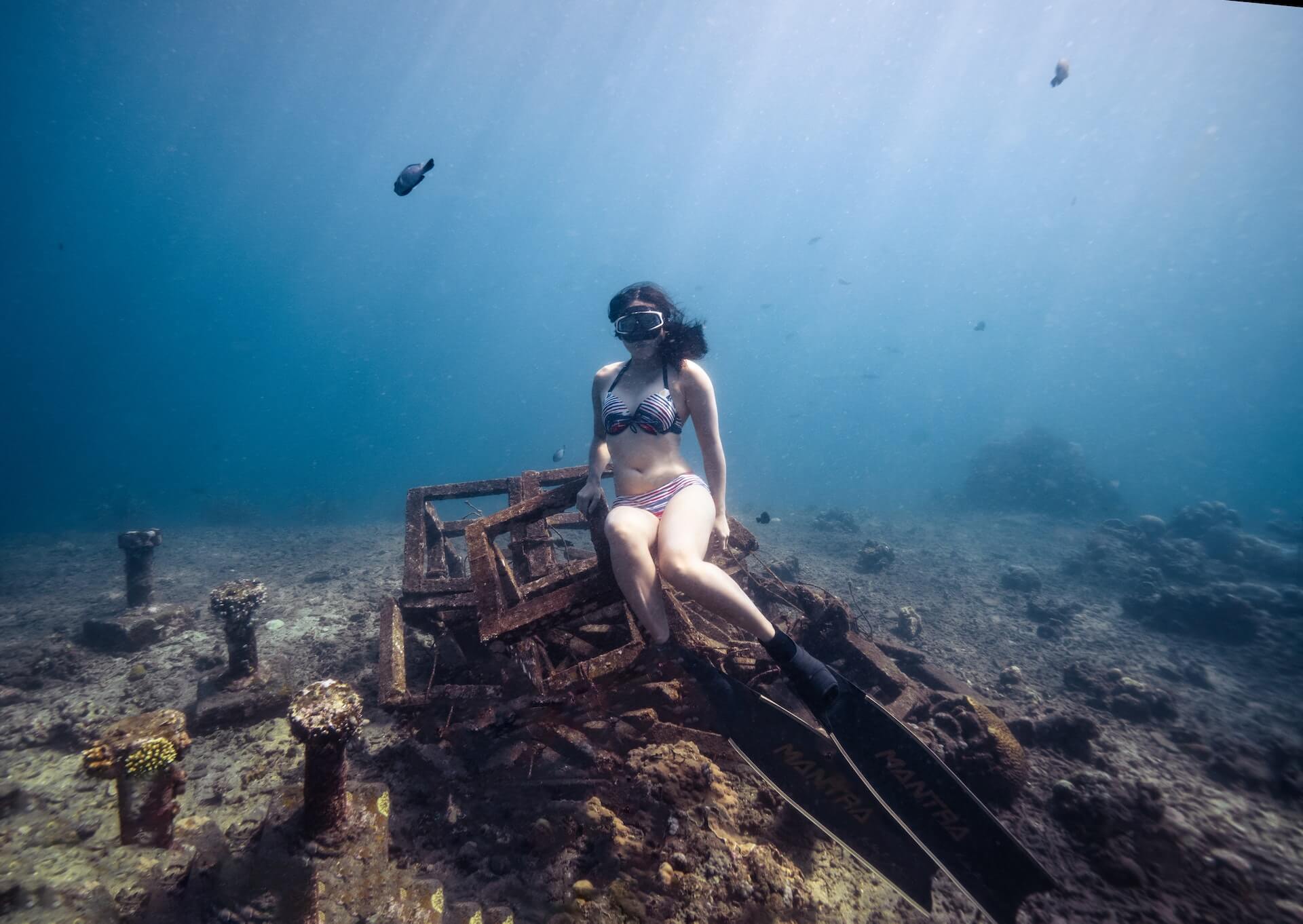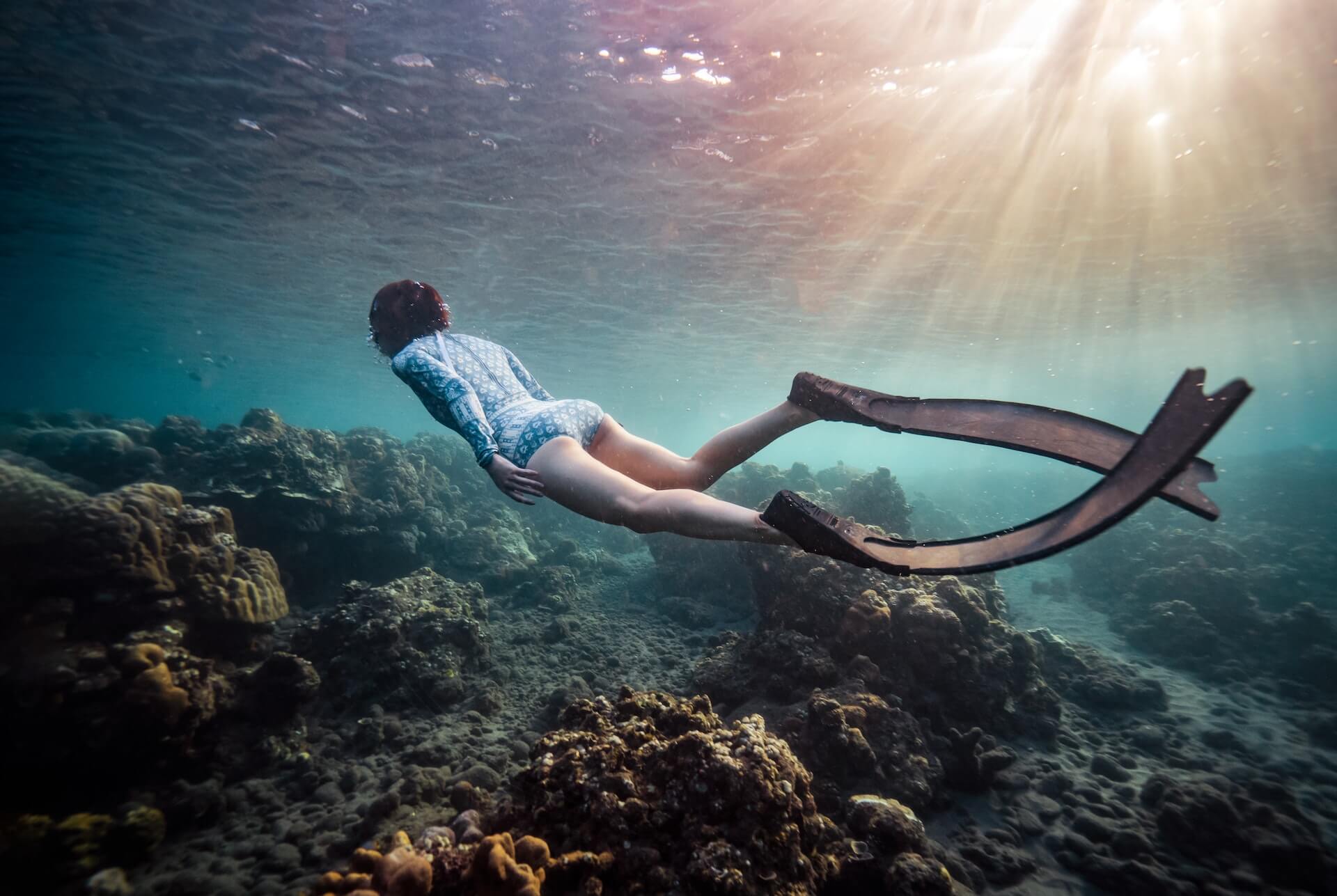Are you a freediver looking to take up snorkeling and are wondering if you can just use your freediving fins instead of buying new snorkel fins? Or perhaps you are simply impressed by the design and function of freediving fins and want to use it for snorkeling as well.

You technically can use freediving fins for snorkeling, but it’s generally not recommended. Freediving fins are much longer than snorkel fins and can make kicking in shallow waters cumbersome; it’s easy to kick up silt and to accidentally damage corals. It may be a decent option when snorkeling in deeper waters where you will also dive underwater.
In this article, we will go over whether or not freediving fins are good for snorkeling.
Downsides of Using Freediving Fins for Snorkeling
Safety Concerns
Freediving fins are distinctively longer than the fins typically used for snorkeling. This length, while advantageous in certain deep-water settings, poses a safety risk during snorkeling activities.
The reason behind this is that the longer fins make quick maneuvers more challenging. Imagine trying to make a sudden turn or stop while wearing lengthy extensions on your feet—it’s not easy.
Especially in conditions where rapid reactions might be necessary, such as when encountering unexpected marine life, navigating around sharp corals, or avoiding other snorkelers, the responsiveness is crucial.
With freediving fins, the delay in maneuvering can increase the risk of accidents, minor injuries, or unintentional environmental disruption.
Increased Fatigue
At first glance, it might seem that longer fins would make swimming easier, as they provide more propulsion. However, the reality is a bit more complex.
Freediving fins, due to their length and design, require more effort with each kick compared to shorter snorkeling fins. This difference means that, over time, the legs and feet can tire out more quickly, especially for individuals not accustomed to the unique resistance these fins offer.
For casual snorkelers, this added fatigue can detract from the enjoyment of the experience, limit the duration of the activity, and even raise safety concerns, as tired swimmers might struggle with strong currents or in unexpected situations.
Risk of Damaging Coral
Coral reefs are among the most vibrant, diverse, and fragile ecosystems on our planet. Protecting them is not only essential for the marine environment but also for the countless species, including humans, who depend on them.
Longer freediving fins, due to their extended reach, increase the chances of snorkelers accidentally striking these delicate structures. Even slight contact can cause significant damage to corals, which often take years to recover, if they recover at all.
For snorkelers who are passionate about marine conservation, using appropriate gear is a direct way to minimize their environmental footprint and ensure they’re observing without harming.
Difficulty in Shallow Waters

For those who have tried walking in flippers on land, the challenge is apparent. Now, imagine those flippers being much longer and trying to navigate shallow waters with them. In areas where the water isn’t very deep, the extended length of freediving fins can cause them to drag on the seabed, making movement awkward and cumbersome.
Beyond the obvious discomfort and inconvenience this presents to the snorkeler, there’s also a risk of disrupting marine habitats. Stirring up the sand can smother marine plants and small creatures, and there’s also a danger of accidentally stepping on marine life.
Using shorter, snorkeling-specific fins ensures better control and a lower likelihood of causing unintentional harm.
Inexperience with Equipment
Every sport or activity has its learning curve, and using specialized equipment is no exception. For individuals unfamiliar with freediving fins, there might be a period of adjustment. This adjustment is not merely about physical technique; it’s also about understanding how the fins respond in different underwater conditions.
An improper or inefficient kick can lead to muscle strains or even cramping, significantly impacting one’s snorkeling experience. Beyond the physical demands, there’s also the psychological factor.
Feeling “out of one’s depth” with unfamiliar gear can create anxiety, which isn’t ideal when trying to enjoy the serene beauty of underwater environments. For a casual snorkeler, sticking to familiar and purpose-designed equipment ensures a more comfortable and enjoyable experience.
Increased Water Resistance
For those new to water activities, it might seem counterintuitive, but the larger surface area of freediving fins can sometimes be a disadvantage. These fins are designed to provide maximum propulsion in deep waters, which requires displacing more water with each kick.
While this is perfect for the deep dives of freediving, it introduces more water resistance during casual, surface-level snorkeling. This increased resistance can make movements feel more laborious and potentially contribute to quicker fatigue, especially for those not trained in the techniques of using these fins.
Transportation Issues
Anyone who has traveled with sports or recreational equipment knows that size and convenience play a significant role.
Freediving fins, due to their extended length, can be a logistical challenge. Unlike shorter snorkeling fins, which often fit comfortably in standard dive bags or suitcases, the long fins demand extra considerations.
Whether it’s finding a bag that can accommodate their size, worrying about them getting damaged in transit, or managing additional airline fees due to oversized luggage, the hassles can accumulate.
For a snorkeler planning to explore multiple spots or hopping between islands, the added inconvenience of managing bulky equipment can be a deterrent.
Expense
Quality recreational equipment often comes at a cost, and freediving fins are no exception. Typically crafted with specialized materials and designed for the specific demands of freediving, these fins can carry a heftier price tag than regular snorkeling fins.
For someone who’s primarily interested in snorkeling and doesn’t intend to delve into the world of freediving, investing in these fins might not provide the best value for money. It’s like buying professional-grade equipment for a hobby—it might look and feel impressive, but if you’re not harnessing its full potential, the investment can be better directed elsewhere.
Making informed choices based on one’s actual needs ensures that resources are spent wisely and effectively.
Frequently Asked Questions
What are the main differences between snorkeling fins and freediving fins?
Snorkeling fins and freediving fins are both designed to enhance propulsion in the water, but they serve different primary purposes and thus come with a variety of distinguishing features:
- Length: The most noticeable difference is the length. Freediving fins are significantly longer than snorkeling fins. This length provides freedivers with increased propulsion, allowing them to descend to greater depths more efficiently. On the other hand, snorkeling fins are shorter to give swimmers agility in shallow waters.
- Material: Freediving fins can be made from various materials, including plastic, fiberglass, carbon fiber, and sometimes a combination of these. Carbon fiber and fiberglass fins offer more flexibility and efficiency but are more expensive. Snorkeling fins are commonly made of rubber or plastic.
- Stiffness: The stiffness of a fin determines how much energy is required to kick and how much propulsion one gets in return. Freediving fins tend to vary in stiffness, with some being very flexible to aid deep dives. In contrast, snorkeling fins tend to be stiffer to provide quick bursts of speed.
- Foot pocket: The design of the foot pocket can differ as well. Freediving fins often have a full-foot pocket, meaning they encompass the entire foot, while snorkeling fins can come in both full-foot and open-heel designs. The latter allows for adjustment and is worn with booties.
How do I handle the increased water resistance when using freediving fins for snorkeling?
Handling the increased water resistance of freediving fins while snorkeling requires adjustments to your kicking technique and awareness:
- Modified Kick: Adopt a longer, slower, and more rhythmic kick. This will help in maximizing the propulsion from the longer fins while minimizing fatigue.
- Leg Strength: Engage your core and upper leg muscles more than your calves. This reduces the risk of cramping and improves efficiency.
- Buoyancy: Being neutrally buoyant will help reduce unnecessary drag. Ensure you are weighted appropriately and adjust your buoyancy with breath control.
- Awareness: Be conscious of your surroundings, especially in shallow areas. The length of freediving fins can easily cause you to come into contact with the seabed or coral.
- Practice: Spend time practicing in a controlled environment, like a swimming pool, to get used to the feel and resistance before venturing into open water.
Are there advantages to using freediving fins for snorkeling compared to regular fins?
Yes, there are advantages to using freediving fins for snorkeling:
- Greater Propulsion: Their length and flexibility can provide powerful propulsion with each kick, allowing snorkelers to cover larger distances with fewer strokes if they have the leg strength for it.
- Energy Efficiency: When used correctly, the prolonged glide offered by freediving fins can be more energy-efficient over long distances.
- Versatility: For those who enjoy both snorkeling and freediving, having a pair of freediving fins can serve dual purposes.
- Depth: For snorkelers who like to make occasional deeper dives to explore underwater features, freediving fins can make these dives easier and more efficient.
However, these advantages come with the aforementioned challenges, such as increased water resistance and maneuverability issues in shallow waters.
How do I choose the right freediving fins if I want to use them for snorkeling too?
When selecting freediving fins for snorkeling, consider the following factors:
- Purpose: If you’re splitting your time between freediving and snorkeling, look for a versatile fin that offers a balance between propulsion and maneuverability.
- Material: If you’re on a budget, plastic fins might be more affordable. However, for a blend of flexibility and responsiveness, fiberglass or carbon fiber are better choices.
- Stiffness: Opt for a medium stiffness for a blend of agility and propulsion.
- Foot Pocket Fit: Ensure a comfortable and snug fit. A poorly fitting fin can lead to blisters or lost fins during swims.
- Length: If primary use is snorkeling, consider slightly shorter freediving fins to gain some agility in shallow waters.
Sources:
